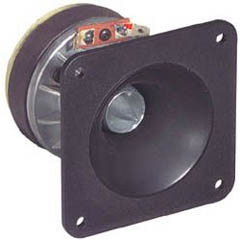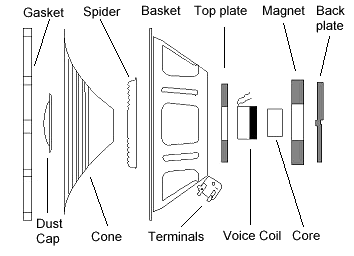Blog, Technically Speaking
speaker info- definitions
 A loudspeaker, or simply speaker, is an electromechanical transducer which converts an electrical signal into sound. The term loudspeaker is used to refer to both the device itself, and a complete system consisting of one or more loudspeaker drivers (as the individual units are often called) in an enclosure. One problem with loudspeakers is that the essentially-planar form of most loudspeakers creates a soundwave that is somewhat directional, that is, the intensity of the sound produced varies depending on the listener’s angle relative to the central axis of the speaker. This is especially a problem for high frequencies where the loudspeaker may be physically large compared to the wavelength of the sound being reproduced. A point source or a sphere that varies in size with the amplitude of the desired pressure wave would avoid this problem of beam-formation but is generally physically impossible or impractical. Several approaches have attempted to remedy this by approximating the sphere.
A loudspeaker, or simply speaker, is an electromechanical transducer which converts an electrical signal into sound. The term loudspeaker is used to refer to both the device itself, and a complete system consisting of one or more loudspeaker drivers (as the individual units are often called) in an enclosure. One problem with loudspeakers is that the essentially-planar form of most loudspeakers creates a soundwave that is somewhat directional, that is, the intensity of the sound produced varies depending on the listener’s angle relative to the central axis of the speaker. This is especially a problem for high frequencies where the loudspeaker may be physically large compared to the wavelength of the sound being reproduced. A point source or a sphere that varies in size with the amplitude of the desired pressure wave would avoid this problem of beam-formation but is generally physically impossible or impractical. Several approaches have attempted to remedy this by approximating the sphere.
 For high frequencies, a variation on the common dynamic loudspeaker design uses a small dome as the moving part instead of an inverted cone. This design is typically used for tweeters and sometimes for mid-range speakers. Because the wavelength of high-frequency sound is short (approximately 15 mm at 20 kHz), tweeters must have a physically small moving component or they will create a “beam” of sound rather than sending sound omnidirectionally (as is usually desired). Perhaps contrary to intuition, making the moving component in the form of a dome rather than an inverted cone does not help to direct sound evenly in all directions. The dome is used because it is an easily manufactured stiff structure – as anyone who has attempted to crush an egg the long way can attest to. The stiffness moves self resonances upward in frequency.
For high frequencies, a variation on the common dynamic loudspeaker design uses a small dome as the moving part instead of an inverted cone. This design is typically used for tweeters and sometimes for mid-range speakers. Because the wavelength of high-frequency sound is short (approximately 15 mm at 20 kHz), tweeters must have a physically small moving component or they will create a “beam” of sound rather than sending sound omnidirectionally (as is usually desired). Perhaps contrary to intuition, making the moving component in the form of a dome rather than an inverted cone does not help to direct sound evenly in all directions. The dome is used because it is an easily manufactured stiff structure – as anyone who has attempted to crush an egg the long way can attest to. The stiffness moves self resonances upward in frequency.


